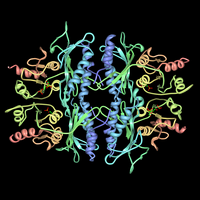Fructose 1,6-bisphosphatase
Fructose bisphosphatase (EC 3.1.3.11) is an enzyme that converts fructose-1,6-bisphosphate to fructose 6-phosphate in gluconeogenesis and the Calvin cycle which are both anabolic pathways. Fructose bisphosphatase catalyses the reverse of the reaction which is catalysed by phosphofructokinase in glycolysis. These enzymes only catalyse the reaction in one direction each, and are regulated by metabolites such as fructose 2,6-bisphosphate so that high activity of one of the two enzymes is accompanied by low activity of the other. More specifically, fructose 2,6-bisphosphate allosterically inhibits fructose 1,6-bisphosphatase, but activates phosphofructokinase-I. Fructose 1,6-bisphosphatase is involved in many different metabolic pathways and found in most organisms. FBPase requires metal ions for catalysis (Mg2+ and Mn2+ being preferred) and the enzyme is potently inhibited by Li+.
The fold of fructose-1,6-bisphosphatase from pig was noted to be identical to that of inositol-1-phosphatase (IMPase).Inositol polyphosphate 1-phosphatase (IPPase), IMPase and FBPase share a sequence motif (Asp-Pro-Ile/Leu-Asp-Gly/Ser-Thr/Ser) which has been shown to bind metal ions and participate in catalysis. This motif is also found in the distantly-related fungal, bacterial and yeast IMPase homologues. It has been suggested that these proteins define an ancient structurally conserved family involved in diverse metabolic pathways, including inositol signalling, gluconeogenesis, sulphate assimilation and possibly quinone metabolism.
...
Wikipedia



